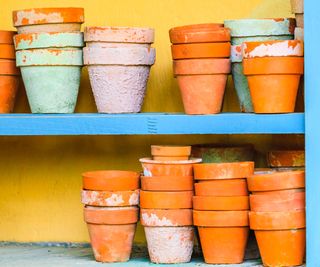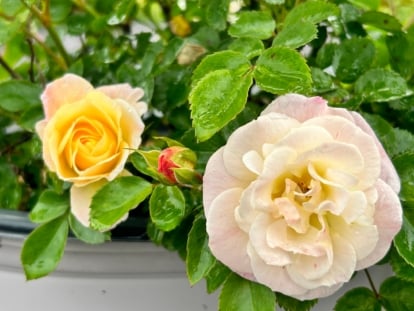Container gardening is the solution to so many gardening problems. Do you have poor soil? Are you a beginning gardener? Maybe moles are eating everything? Or maybe your plants need occasional relocating? In all these cases (and more), planting flowers or vegetables in a container can resolve the issue for you. Once you have a handle on the basic pros and cons of container growing, it’s clear why it has such appeal.
For many city dwellers and gardeners who are just starting out, a vegetable garden seems like an impossible dream. For those who don’t have large properties and oodles of space, there really is no lower 40 to plow. But container gardens – for herbs, vegetables or flowers – are possible in almost any place. And since they are portable, you can move them around to get the best of the weather during the growing season and beyond.
Benefits of Container Gardening
The benefits of growing plants in containers instead of an in-ground garden bed start here: you can have a container garden on a small, sunny balcony, a back patio, or even a fire escape. Containers also work well for those with rocky, sandy, muddy or highly acidic soil, since potting soil works well for container plants.
While you might fret about making mistakes with containers, it can often be easier than ground-based growing. By adding a little creativity into the mix, you can grow veggies and flowers in the same containers, and time your plantings to provide a garden all season long. There are three key steps to getting started with container gardening: picking the container, soil, and plants. Once these selections are made, you’re pretty much good to go.
(Image credit: John McKeen / Getty Images)
Choosing Your Container
Anything from an empty bean can to a bathtub can work as a container for plants, and believe me, I’ve seen some pretty unusual planting containers. When it comes to designing a container-based vegetable garden, anything goes: I’ve even planted strawberries in an old shoe hanger! The classics, however, are pots, planters, and hanging baskets. Be creative if you like but avoid anything that might be toxic, including plastic or wood that has been treated with chemicals.
Your containers need to allow for drainage, so be sure they have ample drain holes. Hardly anything will grow well in water-logged soil. Size also matters. The more imposing the mature root structure of the plants you choose, the bigger the pots you will need. Plants like lettuce don’t need very deep soil.
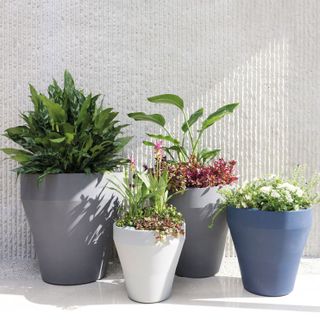
TruDrop Rim Self-Watering Modern Round Planter
These planters from Crescent Garden are ideal for the first-time gardener or the savvy enthusiast. The TruDrop system results in healthy plants and efficient gardening.
Selecting the Soil Mix
Don’t agonize over planting soil. Purchase a quality potting soil from a garden store, ideally one that contains compost for nutrients to help give growing plants a boost. There are lots of peat-free options available, blended with ingredients such as coir or composted bark. Buying potting soil helps to ensure that it is free from disease. Avoid using soil straight from the garden, which might contain weed seeds.
It’s wise to give some thought to the plants you will be housing. If you are growing Mediterranean plants (for instance, herbs such as lavender, rosemary or thyme), it is beneficial to adjust the quality of the potting soil with more sand. This can help with drainage and prevent compaction. Also, if you’re growing acid-loving plants such as azaleas or blueberries, be sure to use an ericaceous blend.
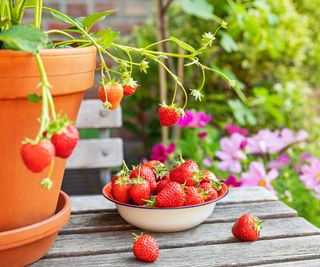
(Image credit: Westend61 / Getty Images)
Picking Your Container Plants
Container gardening is a fun and practical way of maximizing your planting potential, so there’s nothing to stop you getting creative with planting choices. If you’re starting out with container planting, consider growing container-based strawberries or compact cherry tomatoes, or other small fruits and vegetables. Edible greens like lettuce or spinach can work well. Peppers grow well in pots and are very pretty. Climbing plants like peas are also fun if you get a trellis for your container.
If you fancy florals and vibrant ornamentals, try container-based geraniums, coral bells, stonecrops or caladiums. Or if you fancy something fragrant, most herbs are easy to start with. Perennial herbs like lavender, thyme or chives grow back year after year. You can even pot up bigger flowering plants like hydrangea, azalea and hebe, as long as your container is big enough, well draining, and carefully situated.
As to which plants work best in containers, the only limitations will relate to whether you wish to grow in sunny areas or in shade. In this respect, your choices are pretty much as they would be for ground-based planting. With the right size container, the right potting soil and the right care, the rest is an enjoyable process of discovery!
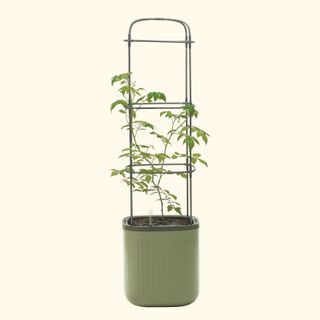
Self-Watering Rolling Tomato Planter Pot With Trellis
Give container-based crops support as well as a hassle-free water supply. Available in sage green, cream and gray, this Vego Garden container works hard during the growing and fruiting season.
How to Care for Your Container Garden
Whether you are growing hot weather container plants or shade-based options, planting a container garden is fairly straightforward. You can buy seeds or, to create a garden faster, you can plant starts or plugs. You can even buy little potted herbs (like basil) from the grocery store and transplant those into your container garden. Container gardening for beginners doesn’t require a lot of specialist knowledge. You just have to keep your eye on a few cultivation essentials.
Since space (and therefore potting soil) is limited in a container, the water and nutrients available to container plants are also limited. That means you’ll need to irrigate and fertilize container plants more regularly than you would bed plants. The following are the key factors to consider as you go.
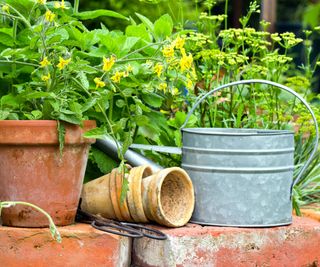
(Image credit: Cora Mueller / Getty Images)
- Watering: Container plants require watering weekly, biweekly or even daily, depending on the size of the container and the weather. The more sun, heat or wind the plants experience, the more water they need. You’ll do well to check the soil daily and water when it feels dry. When you do water, do so generously, keeping the water coming until it exits from the drainage holes. Conversely, reduce watering when the weather is wetter. Plants can get stressed from waterlogging, and this in turn can make them more vulnerable to container problems like fungal issues.
- Fertilizing: Any nutrients in potting soil will leach out relatively quickly as you water frequently. You will need to keep feeding potted garden plants by adding fertilizer on a regular basis. You can do this by working a dry, slow-release fertilizer into the soil every month, or by using water soluble fertilizer at a reduced dose with every irrigation. Be sure you know whether your soil includes fertilizer before you start adding more.
- Overwintering: If you’re just planting annuals like California poppies or lettuce, there’s no need to think about overwintering. By the time the season ends, you harvest the veggies or say goodbye to the flowers. But if you plant ornamental perennials like hydrangeas, or perennial edibles like rosemary, extending a plant’s life over the colder months is important. In the main, container gardening in winter is nothing to be afraid of – you just need to consider hardiness zones.
Compare your zone to the plant’s hardiness tolerance. For example, if you live in USDA hardiness zone 8, any plants hardy to zone eight are fine to leave out in winter. However, if your zone gets colder than the plant can tolerate (for instance, if you live in zone 8 and the plant is only hardy to zone 9), you’ll need to overwinter it indoors as a houseplant, taking it back outside the following spring.
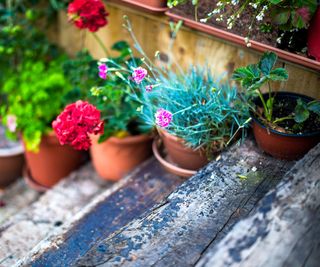
(Image credit: ColdSnowStorm / Getty Images)
Frequently Asked Questions
What are the Best Vegetables to Grow in Containers?
It’s best to grow vegetables that fit well in the container you are using. For example, it’s easier to grow strawberries than watermelon, or lettuce over pumpkins. Root veggies like potatoes might not be ideal. Cherry tomatoes and bush beans are excellent starter projects for beginners. Whether you’re growing fruit and veg in spring or starting off potted crops in the fall, always think about seasonality, light requirements and hardiness zones.
What are the Disadvantages to Container Gardening?
There are a few built-in limitations with container gardening. You’ll obviously have to limit what you grow to the size of your containers. Another disadvantage is the increased need to irrigate and fertilize. Plants in beds can pull more water and nutrients from the soil since they access more soil. But this aside, the benefits do outweigh the disadvantages.
This article features products available from third party vendors on the Gardening Know How Shop.


